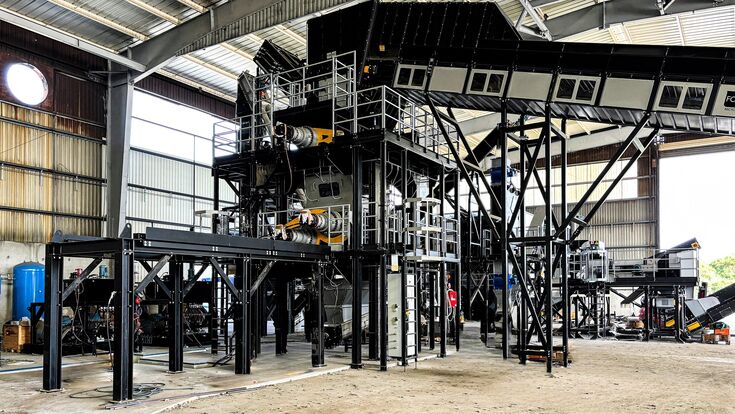Recycling : Recycling of WEEE and photovoltaic panel

As the production and consumption of electronic devices continue to rise, so does the volume of WEEE (Waste Electrical and Electronic Equipment), which encompasses items like refrigerators, washing machines, computers, and small appliances.
Recycling WEEE is crucial for several reasons. First, these devices contain hazardous materials like mercury, lead, and cadmium, which can pollute soil and water if not properly handled. Second, recycling enables the recovery of valuable resources such as gold, copper, and aluminum, reducing the need for new raw material extraction. Finally, it helps reduce greenhouse gas emissions and energy consumption, fostering sustainable waste management.
FOR REC's innovative recycling solutions
FOR REC has developed high-performance machines specifically for WEEE recycling, offering innovative solutions for household and industrial electronic waste. The treatment process combines manual labor with advanced automation, ensuring maximum recovery of components while minimizing waste and environmental impact.
The WEEE recycling process involves several stages:
- Manual Sorting: initial manual inspection to ensure only suitable items are processed.
- Device Opening: devices are opened using specialized shredders that protect recoverable components.
- Separation of Components: machines reduce the size of the materials, separating bulky items like cables and hard drives.
- Final Shredding: an automated process reduces materials to a uniform 30mm size.
- Material Separation: the final step involves separating the materials into ferrous metals, non-ferrous metals, and plastics.
FOR REC’s modular and tailor-made recycling lines are designed to meet specific customer needs and can be enhanced with advanced material separation systems. Their machines operate at low RPM, particularly during the initial stage, preserving the integrity of recoverable components. Additionally, these lines are equipped with soundproof panels and vacuum systems to meet current sound and dust emission regulations.
Refrigerator recycling and specialized equipment
Recycling refrigeration and air conditioning appliances, such as refrigerators and boilers, requires a specialized approach due to hazardous materials like gas, oil, and polyurethane. If not properly treated, these substances can release harmful emissions. Refrigerator recycling process includes:
- Initial Cleanup: removal of engines and separation of oil and gas to prevent harmful emissions.
- Shredding: refrigerants are shredded into 30mm pieces, facilitating material separation.
- Material Separation: ferrous and non-ferrous metals are recovered using an advanced magnet system.
- Grinding: remaining materials are reduced to 5mm, with technologies separating plastic, copper, and aluminum.
- Vacuum and Filtering: CFCs released during polyurethane grinding are vacuumed and fully recovered.
- Compressing and Pelletizing: the final stage compacts and pelletizes polyurethane, rendering it inert and preventing harmful gas emissions.
FOR REC's recycling systems are designed for product valorization, enabling the efficient processing of all refrigerator components without environmental impact. The company’s strength lies in its ability to customize each system to meet specific customer needs. For example, in French overseas territories like Reunion Islands and Guadeloupe, FOR REC developed a hybrid recycling line that activates gas recovery only when necessary, a solution tailored to the local market's requirements.
Photovoltaic panel recycling
As the use of photovoltaic panels grows, so does the need for specialized recycling solutions. FOR REC has created a specific recycling line for photovoltaic panels that separates and recovers materials such as aluminum, magnetic metals, inert fractions, ethylene vinyl acetate (EVA), and non-magnetic metals from wiring and connectors.
The recycling process for photovoltaic panels includes:
- Crushing: Panels are initially crushed using an LC 1800 multi-crusher, followed by manual sorting of connectors and wires.
- Initial Screening: Inert fractions are screened to ease subsequent processing.
- Shredding: A TQ1800 four-shaft shredder further reduces materials with a 50mm screen.
- Magnetic Separation: Magnetic metals are separated.
- Eddy Current Separator: Non-magnetic metals, such as aluminum, are selected.
- Screening: Additional inert fractions are released and cleaned.
- Final EVA Cleaning: Remaining contaminants are removed, ensuring a high-quality final product.
Sustainable waste management with FOR REC
Recycling WEEE and photovoltaic panels is essential for sustainable waste management, reducing environmental impact, and recovering valuable resources. FOR REC’s modular and tailor-made recycling plants are at the forefront of this effort, combining efficiency with innovation to deliver high-performance solutions that reduce treatment costs while maintaining environmental responsibility.
Learn more about how FOR REC recycling systems work!
